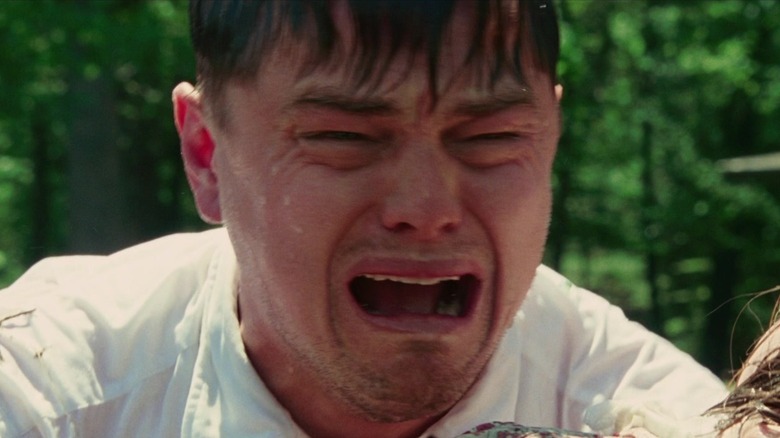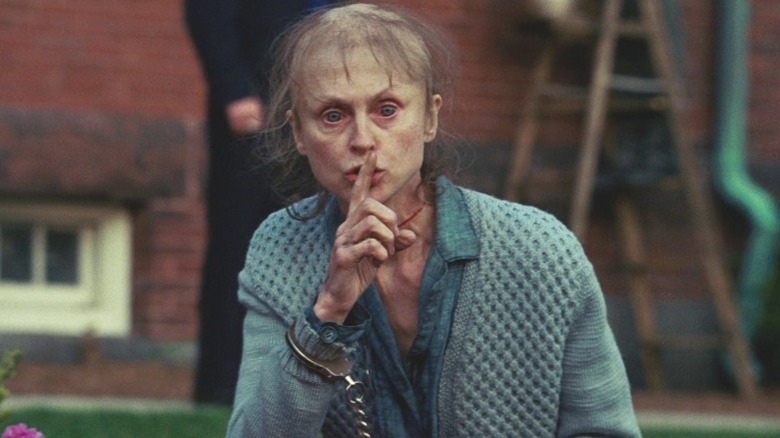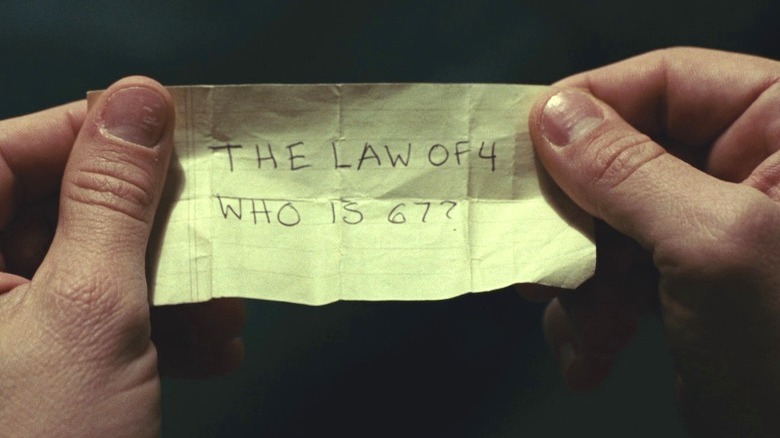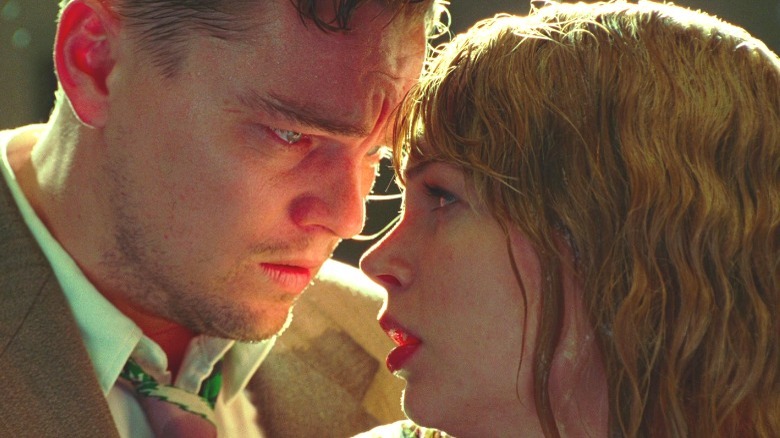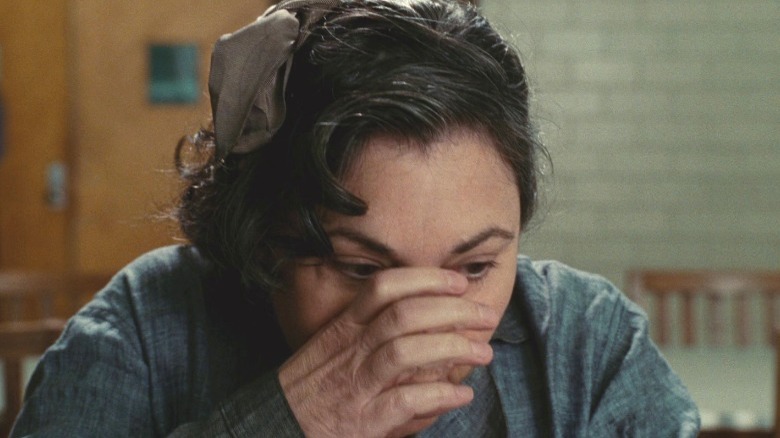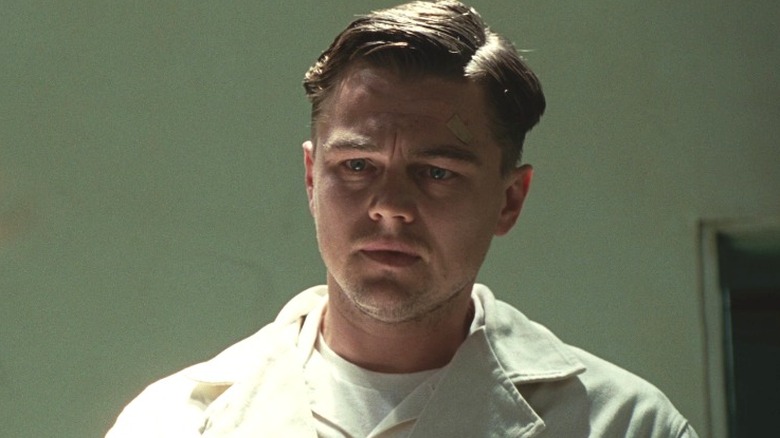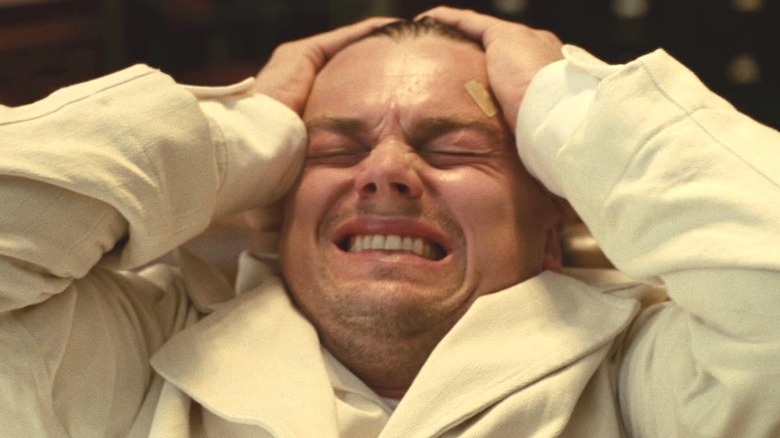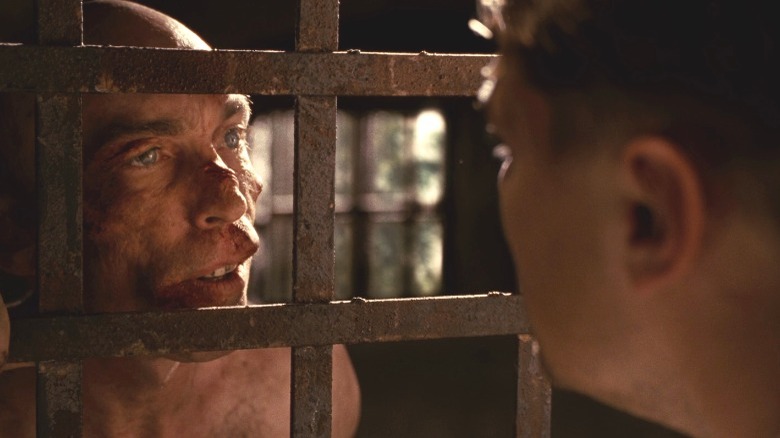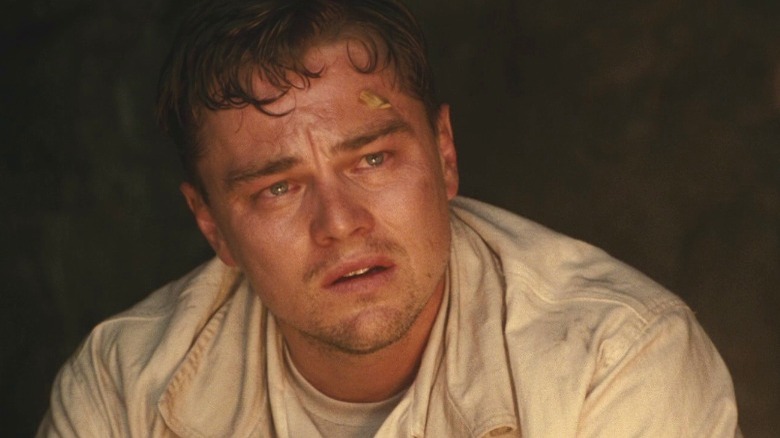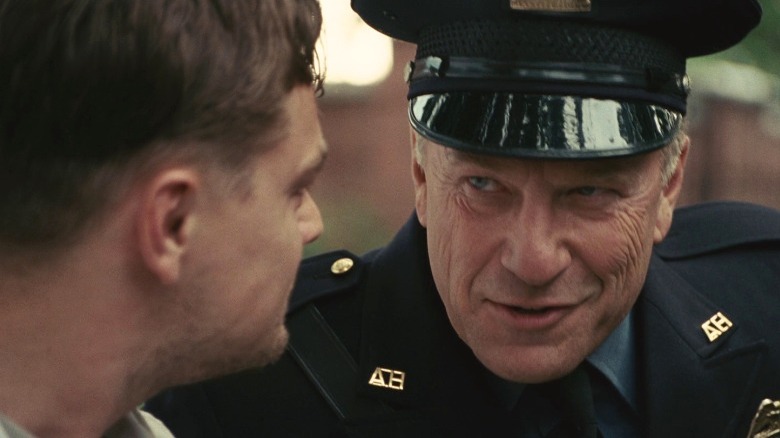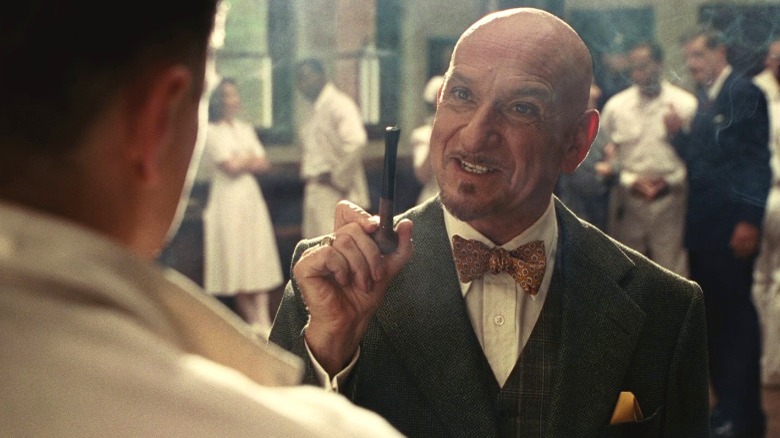Shutter Island's Most Confusing Moments Explained
Martin Scorsese's mystery thriller "Shutter Island" was an immediate hit with audiences upon its release in 2010. Boasting an 82% rating on IMDb based on over 1.3 million votes, it has both captivated and confused audiences since its release over a decade ago. The film features an all-star cast including Leonardo DiCaprio, Mark Ruffalo, Ben Kingsley, and Michelle Williams. It takes place on the fictional Shutter Island located in the Boston Harbor and was actually shot on location in an abandoned mental institution in the city.
The film follows Edward "Teddy" Daniels (DiCaprio), a U.S. Marshal investigating the disappearance of a young woman from Ashecliffe Hospital on Shutter Island. He teams up with new partner Chuck Aule (Ruffalo) and they try and untangle what they think are a series of conspiracies at the hospital. Ashecliffe is under the watch of Dr. John Cawley (Kingsley), a mysterious figure who appears to be pushing back against Daniels' investigation. Meanwhile, Daniels himself is struggling to deal with flashbacks from his time as a soldier in WWII while trying to conduct his investigation. Or so we think...
The twist ending, with Daniels turning out to actually be Ashecliffe patient Andrew Laeddis, shocked moviegoers with its misdirection and ambiguity, bringing two-and-a-half hours of beautiful cinema to a haunting close. Watching "Shutter Island" for the first time, there are quite a few baffling and bewildering moments, and we're here to break them down. These are the film's most confusing moments, explained.
Laeddis' strange first interactions at Ashecliffe
One of the more confusing scenes in "Shutter Island" happens right at the beginning of the movie, when U.S. Marshals Edward Daniels and partner Chuck Aule first arrive at Ashecliffe Hospital for the Criminally Insane. As Daniels and Aule are being introduced to Shutter Island by Deputy Warden McPherson (John Carroll Lynch), all of the guards seem to be on edge and giving Daniels strange looks. Several of them are holding their guns and look ready for action, and others give Daniels intense stares like they know who he is. Daniels even comments on their unease, which McPherson vaguely acknowledges.
Things escalate further when he arrives at the hospital, as the patients seem to be giving him weird vibes, too. One of them waves and smiles, while another holds her finger up to her mouth and shushes him, before also breaking out into a smile.
At first, it's not clear why everyone is treating him this way, but after you understand the ending it all makes sense. The guards are all on edge because they know Daniels, aka Andrew Laeddis, is an Ashecliffe patient who is prone to extreme fits of violence. They are all worried he might potentially snap out of his delusions and become physical, hence their precautions. The patients all treat him strangely because they know he's one of them, but they have been told not to engage him. They acknowledge his presence, but can't interact with him any more than that.
What Rachel Solando's cryptic note really means
U.S. Marshal Edward Daniels is supposedly on Shutter Island to investigate the case of Rachel Solando, a woman who has reportedly gone missing. When Daniels and his partner Chuck Aule search her room they are joined by Dr. John Cawley, and immediately Daniels discovers a note hidden under one of the tiles beneath her bed.
The note cryptically reads, "The Law of 4; Who is 67?" Neither Daniels, Aule, nor Cawley is sure what the note means, and it's very confusing for the audience as well. Not only are the words seemingly hinting at some kind of conspiracy, but Cawley's reaction makes it seem like he might be potentially hiding something. Yet, while at the time it's confusing, once again knowing the ending makes it much more clear.
Since there was never a Rachel in the first place, as that was just a ruse to give Daniels a reason to be on the island, the note was fake. Cawley placed the note there hoping to potentially trigger something in Laeddis's mind and force him to confront his delusion. The law of 4 refers to Andrew Laeddis and Edward Daniels as well as Dolores Chanal and Rachel Solando, being anagrams of each other; and 67 refers to Ashecliffe's 67th patient, which is Laeddis himself. The note also helps Cawley corroborate his story at the end that the entire thing has been one massive roleplay when he shows Daniels what the note means.
Laeddis' hallucinations with his wife and the war, explained
Throughout "Shutter Island," Edward Daniels constantly struggles with vivid hallucinations and flashbacks. His flashbacks have two recurring themes that eventually come colliding together: the death of his wife Dolores Chanal (Michelle Williams) and three children, and his experiences liberating the Dachau concentration camp during WWII.
When he first sees Dolores in his hallucination, she seems to be on fire before then appearing soaking wet with a massive bloody wound on her stomach. She tells him to stay and investigate Andrew Laeddis, who Daniels says is the arsonist who killed his family but is in reality himself. As the movie progresses his flashbacks become more and more vivid until he finally has one that conflates his experiences at Dachau with the death of his wife and kids, who he envisions as being Rachel instead of Dolores.
As the end makes clear, the flashbacks with Dachau are due to Daniels' PTSD over the horrors of what he saw at the camp, and his hallucinations of Dolores are actually suppressed memories of her death. Laeddis can't bring himself to fully accept that he murdered Dolores after she murdered their kids, so he warps that memory with his time at Dachau and Rachel to stop himself from fully confronting the truth. The roleplay exercise is triggering his flashbacks, but his elaborately constructed delusion prohibits him from reliving the truth, so it's a skewed and distorted vision — which Laeddis himself can't understand.
If you or someone you know needs help with mental health, please contact the Crisis Text Line by texting HOME to 741741, call the National Alliance on Mental Illness helpline at 1-800-950-NAMI (6264), or visit the National Institute of Mental Health website.
The Bridget Kearns interview
One of the most confusing moments in "Shutter Island" happens when U.S. Marshal Edward Daniels is interviewing the various patients at Ashecliffe. During his interview with patient Bridget Kearns (Robin Bartlett), she does a number of confusing things. First, she scribbles something in his notepad, later revealed to be the word RUN. Then, she seems to mime drinking a glass of water, before it then appears empty on the table, yet it once again is half-full when she leaves. Finally, as soon as Daniels mentions the name Andrew Laeddis, she becomes visibly agitated and abruptly ends the interview.
While at first all three of these things appear incredibly confusing, they actually all have very reasonable explanations. She wrote "RUN" on the note almost certainly because she was instructed to by Dr. Cawley as part of the roleplay. She becomes agitated at the mention of Laeddis because she knows that Daniels is actually Laeddis but he is in the midst of his delusion.
The water part is probably the most confusing. At first, it almost appears like a mistake in continuity, but Daniels' reactions belie that idea. In actuality, whenever we see the glass from Daniels' perspective there is no water, but from every other perspective, we can see the water. This is because Daniels is attempting to block out the water because it reminds him of the drowning of his kids. He is suppressing seeing the water to stop himself from thinking about their true death.
Daniels' confusing interview with Rachel Solando
Following their search of Ashecliff's grounds for Rachel Solando, Edward Daniels and Chuck Aule return to the hospital to find that she has already been found. What follows is a very confounding scene where Daniels and Aule interview Rachel in her room. She refuses to acknowledge being missing and seems to think that Daniels is her dead husband Jim Solando, and instead claims she was dropping off her kids at school before taking a swim in the lake, something which visibly affects Daniels as he hears it.
They then briefly embrace with him playing Jim before she abruptly snaps out of it and starts berating Daniels for not being her husband. The entire ordeal is very bewildering at first, and it's later revealed that Rachel was never a real person, and the woman talking with Daniels and Aule was actually a nurse at the hospital roleplaying.
It's not until you watch a second time that you realize that the story that "Rachel" is giving is actually somewhat close to the real story of Daniels' wife's death. She describes swimming in a lake, as Dolores had done, and Daniels starts to clam up when she says so. It's because he is trying to fight the memory of his wife's death, which Rachel is trying to stir up as part of Dr. Cawley's elaborate treatment plan. Daniels invented the delusion of Rachel, and Dr. Cawley had to shatter it as part of the treatment process.
Daniels' migraine headache explained
Immediately following their interrogation of Rachel Solando, Edward Daniels and his partner Chuck Aule follow Dr. Cawley back to his office to continue speaking. However, as soon as they walk in Daniels begins showing symptoms of a migraine headache. He appears to be in searing pain, and has immense sensitivity to light, or as Dr. Cawley described it, "imagine someone opened up your head, filled it with razors, and shook it as hard as they could." The doctor offers Daniels pills for the pain, which he reluctantly takes after it becomes too unbearable.
While at the time the migraine and Dr. Cawley giving Daniels pills appear suspicious, something which is backed up later during his hallucinatory conversation with Rachel Solando in the cave, the explanation is actually much more reasonable. Not only was the migraine headache probably completely real, but the pills Dr. Cawley gave him probably were just aspirin as he implies.
It's mentioned that Daniels has a history of migraine headaches already, and it's also later revealed that the doctor took Daniels, aka Andrew Laeddis, off his meds in order for the roleplay to happen. The headache was probably a real migraine brought on by his withdrawal from chlorpromazine, which we know is happening because the doctor says so at the end. The pills were probably just aspirin to get rid of the headache without giving him more chlorpromazine, which would throw off the entire roleplay.
Laeddis and Noyce's prison cell meeting
Coincidentally, as Edward Daniels is investigating Rachel Solando's disappearance at Ashecliffe, the weather on Shutter Island is extremely poor. There are gale force winds and hurricane conditions existing nearly the entire time, which threatens everyone's safety but also plays a part in the roleplay. Either due to the hurricane or as an element of the roleplay, the entire power grid goes down shortly after Daniels acquires a guard uniform once his becomes soaked.
Using his newfound disguises and the lack of security, he strolls into Ward C to investigate Andrew Laeddis who he thinks is a patient there. After violently assaulting another patient in retaliation, Daniels tracks down Laeddis to a cell, only to realize it's George Noyce (Jackie Earle Haley), the person he thinks is his informant. During their conversation, Noyce seems upset with Daniels and refers to him as Laeddis and tells him to let go of his wife's memory, also saying he is responsible for his confinement and condition, which appears emaciated and beaten.
The entire conversation is incredibly cryptic and confusing, but again it actually makes a lot of sense once you understand the ending. Noyce knows that Daniels is Laeddis, so he is speaking to him as such. He's telling him to ignore the hallucination of his wife, who he sees standing next to Noyce in his cell, and comes to terms with reality. Once you realize Noyce is speaking to Laeddis, not about Laeddis, all of the cryptic dialogue becomes clear.
The meeting in the cave
After Edward Daniels' conversation with George Noyce in Ward C, he and partner Chuck Aule further search the grounds of Ashecliffe for clues. Yet, due to his conversation with Noyce, Daniels is suspicious of Aule and thinks might be part of a giant brainwashing experiment at the hospital. They are briefly separated when Daniels seemingly sees Aule's dead body and thinking he has either jumped or fallen off the cliffside, Daniels climbs down to find him.
However, once there he doesn't find Aule, but instead a woman claiming to be the real Rachel Solando (Patricia Clarkson) hiding out in a cave. She informs Daniels that he is part of a huge conspiracy and is being drugged through aspirin and cigarettes by Dr. Cawley. She says she was once a prominent doctor who has been falsely imprisoned after discovering the brainwashing scheme. Rachel warns him that they intend to keep Daniels imprisoned there, as they have her, to keep him from exposing the conspiracy.
The scene is very confusing. On one hand, it seems to imply that the conspiracy is truly happening, but it also appears a bit far-fetched that someone could be in such a clean and healthy condition while surviving in a cave for several days. In actuality, the entire conversation is a hallucination of Daniels. He creates the idea of a trapped psychiatrist to further convince himself everything was a giant conspiracy, so he could stop from acknowledging the truth about his wife and kids.
Laeddis' ride with the warden
After his conversation with Rachel Solando in the cave, Edward Daniels hikes back up the cliff to make his way back to Ashecliffe. On the way, he is picked up by the warden (Ted Levine) who gives him a ride back. At this point, Daniels is convinced there is a massive brainwashing conspiracy going on at Ashecliffe, and he assumes that the warden is part of it and is in on the plan to imprison him.
On their ride back, the warden makes a variety of cryptic remarks about the violence inside both of them, saying there is no moral order in the world just a competition of violence. He implies that he knows Daniels on a psychological level, and says that even though Cawley believes he can be controlled, he knows differently. At the time, it seems like the warden is acknowledging that there is something untoward happening at the hospital, but his references to violence and Cawley muddy things.
However, when watching the conversation after knowing the truth about Daniels being patient Andrew Laeddis, it starts to make sense. The warden is referring to Laeddis's propensity for violence, and also to the roleplay itself. As Dr. Cawley reveals later, it's only he and Dr. Sheehan (aka Chuck Aule) who believe in the roleplay, with the warden thinking it won't work. This is the warden's way of telling Laeddis he thinks he is incurable and will always be a patient at Ashecliffe.
Laeddis' conversation with Dr. Cawley
After his cryptic conversation with the warden, Edward Daniels returns to Ashecliffe hospital and has a brief conversation with Dr. Cawley. While they are speaking, all of the other patients start looking at him strangely, even after they are told to ignore him, and even the staff seems to be on heightened awareness over his presence. With Rachel Solando having been found Dr. Cawley suggests that Daniels will be returning to the mainland, which surprises Daniels as he believes he is going to be kidnaped.
However, in a huge twist, when he asks about his partner Chuck Aule, who has been at his side the entire movie, Dr. Cawley questions who he is talking about and tells him he has been alone since arriving. Daniels is initially confused, but he starts to go along with it, as it seems like the doctor is basically telling him that there is a brainwashing conspiracy and that there is nothing he can do to stop it.
At first, it seems like Dr. Cawley is confirming the existence of the conspiracy, but in hindsight, it was part of the roleplaying experiment. He needed to give Laeddis a motive to explore the lighthouse and see for himself there were no Nazi experiments going on. Convincing him that Aule was in the lighthouse being brainwashed drives Daniels, aka Andrew Laeddis, to explore the lighthouse himself where Dr. Cawley can confront him and end the delusion once and for all.
Laeddis' final words explained
After his massive breakthrough with Dr. Cawley and Dr. Sheehan, Andrew Laeddis has seemingly recovered. He is able to admit to them and the warden that he is Laeddis, not Edward Daniels, and that he murdered his wife. Yet, as Laeddis and Dr. Sheehan are sitting on the hospital step he seemingly regresses. His demeanor changes and his brow furrows again, and he starts referring to Dr. Sheehan as his partner Chuck Aule again, ostensibly falling back into the delusion of being Daniels.
In one final remark to Dr. Sheehan, he asks, "Which would be worse, to live as a monster, or die as a good man?" His demeanor again briefly changes back to Laeddis as he looks at Sheehan before he returns to being Daniels again as he gets up and walks towards Dr. Naehring and the warden.
The ending has long been the subject of debate, with people claiming a litany of meanings. The book ending has Laeddis regressing with no final words about living as a monster. However, the cinematic ending is likely different. Martin Scorsese is trying to show that Laeddis acknowledges that he murdered his wife after she drowned their kids, but he can't bring himself to go on living with that reality. Instead, he is choosing to be lobotomized to stop himself from living with the truth every day. It's an absolutely heartbreaking ending, with Laeddis seemingly walking towards his metaphorical execution as the movie ends.
